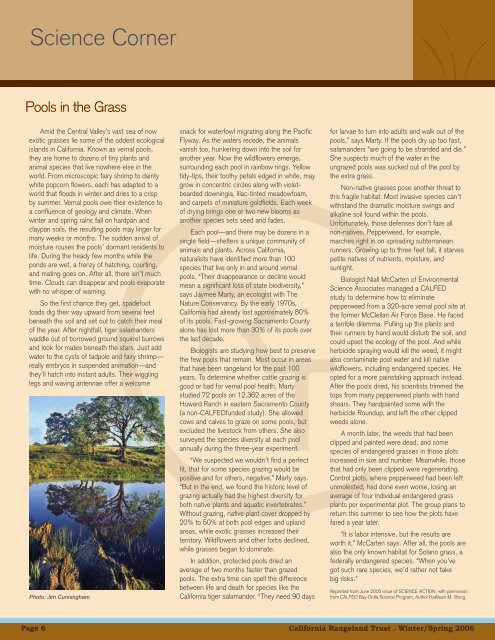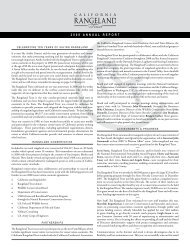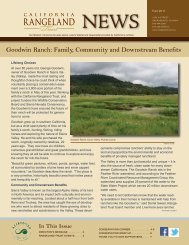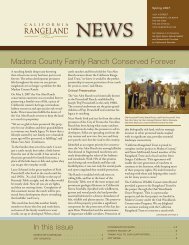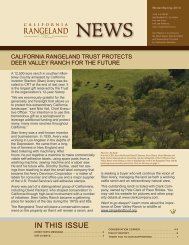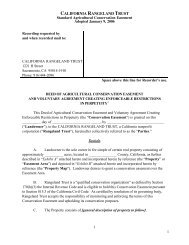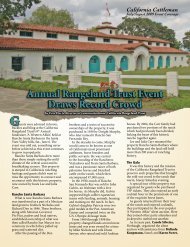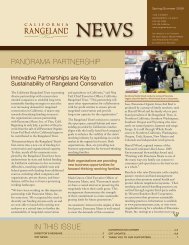CRT - Summer 2006 Newsletter - The California Rangeland Trust
CRT - Summer 2006 Newsletter - The California Rangeland Trust
CRT - Summer 2006 Newsletter - The California Rangeland Trust
Create successful ePaper yourself
Turn your PDF publications into a flip-book with our unique Google optimized e-Paper software.
Science Corner<br />
Pools in the Grass<br />
Amid the Central Valley’s vast sea of now<br />
exotic grasses lie some of the oddest ecological<br />
islands in <strong>California</strong>. Known as vernal pools,<br />
they are home to dozens of tiny plants and<br />
animal species that live nowhere else in the<br />
world. From microscopic fairy shrimp to dainty<br />
white popcorn flowers, each has adapted to a<br />
world that floods in winter and dries to a crisp<br />
by summer. Vernal pools owe their existence to<br />
a confluence of geology and climate. When<br />
winter and spring rains fall on hardpan and<br />
claypan soils, the resulting pools may linger for<br />
many weeks or months. <strong>The</strong> sudden arrival of<br />
moisture rouses the pools’ dormant residents to<br />
life. During the heady few months while the<br />
ponds are wet, a frenzy of hatching, courting,<br />
and mating goes on. After all, there isn’t much<br />
time. Clouds can disappear and pools evaporate<br />
with no whisper of warning.<br />
So the first chance they get, spadefoot<br />
toads dig their way upward from several feet<br />
beneath the soil and set out to catch their meal<br />
of the year. After nightfall, tiger salamanders<br />
waddle out of borrowed ground squirrel burrows<br />
and look for mates beneath the stars. Just add<br />
water to the cysts of tadpole and fairy shrimp—<br />
really embryos in suspended animation—and<br />
they’ll hatch into instant adults. <strong>The</strong>ir wiggling<br />
legs and waving antennae offer a welcome<br />
Photo: Jim Cunningham<br />
snack for waterfowl migrating along the Pacific<br />
Flyway. As the waters recede, the animals<br />
vanish too, hunkering down into the soil for<br />
another year. Now the wildflowers emerge,<br />
surrounding each pool in rainbow rings. Yellow<br />
tidy-tips, their toothy petals edged in white, may<br />
grow in concentric circles along with violetbearded<br />
downingia, lilac-tinted meadowfoam,<br />
and carpets of miniature goldfields. Each week<br />
of drying brings one or two new blooms as<br />
another species sets seed and fades.<br />
Each pool—and there may be dozens in a<br />
single field—shelters a unique community of<br />
animals and plants. Across <strong>California</strong>,<br />
naturalists have identified more than 100<br />
species that live only in and around vernal<br />
pools. “<strong>The</strong>ir disappearance or decline would<br />
mean a significant loss of state biodiversity,”<br />
says Jaymee Marty, an ecologist with <strong>The</strong><br />
Nature Conservancy. By the early 1970s,<br />
<strong>California</strong> had already lost approximately 80%<br />
of its pools. Fast-growing Sacramento County<br />
alone has lost more than 30% of its pools over<br />
the last decade.<br />
Biologists are studying how best to preserve<br />
the few pools that remain. Most occur in areas<br />
that have been rangeland for the past 100<br />
years. To determine whether cattle grazing is<br />
good or bad for vernal pool health, Marty<br />
studied 72 pools on 12,362 acres of the<br />
Howard Ranch in eastern Sacramento County<br />
(a non-CALFEDfunded study). She allowed<br />
cows and calves to graze on some pools, but<br />
excluded the livestock from others. She also<br />
surveyed the species diversity at each pool<br />
annually during the three-year experiment.<br />
“We suspected we wouldn’t find a perfect<br />
fit, that for some species grazing would be<br />
positive and for others, negative,” Marty says.<br />
“But in the end, we found the historic level of<br />
grazing actually had the highest diversity for<br />
both native plants and aquatic invertebrates.”<br />
Without grazing, native plant cover dropped by<br />
20% to 50% at both pool edges and upland<br />
areas, while exotic grasses increased their<br />
territory. Wildflowers and other forbs declined,<br />
while grasses began to dominate.<br />
In addition, protected pools dried an<br />
average of two months faster than grazed<br />
pools. <strong>The</strong> extra time can spell the difference<br />
between life and death for species like the<br />
<strong>California</strong> tiger salamander. “<strong>The</strong>y need 90 days<br />
for larvae to turn into adults and walk out of the<br />
pools,” says Marty. If the pools dry up too fast,<br />
salamanders “are going to be stranded and die.”<br />
She suspects much of the water in the<br />
ungrazed pools was sucked out of the pool by<br />
the extra grass.<br />
Non-native grasses pose another threat to<br />
this fragile habitat. Most invasive species can’t<br />
withstand the dramatic moisture swings and<br />
alkaline soil found within the pools.<br />
Unfortunately, those defenses don’t faze all<br />
non-natives. Pepperweed, for example,<br />
marches right in on spreading subterranean<br />
runners. Growing up to three feet tall, it starves<br />
petite natives of nutrients, moisture, and<br />
sunlight.<br />
Biologist Niall McCarten of Environmental<br />
Science Associates managed a CALFED<br />
study to determine how to eliminate<br />
pepperweed from a 320-acre vernal pool site at<br />
the former McClellan Air Force Base. He faced<br />
a terrible dilemma. Pulling up the plants and<br />
their runners by hand would disturb the soil, and<br />
could upset the ecology of the pool. And while<br />
herbicide spraying would kill the weed, it might<br />
also contaminate pool water and kill native<br />
wildflowers, including endangered species. He<br />
opted for a more painstaking approach instead.<br />
After the pools dried, his scientists trimmed the<br />
tops from many pepperweed plants with hand<br />
shears. <strong>The</strong>y handpainted some with the<br />
herbicide Roundup, and left the other clipped<br />
weeds alone.<br />
A month later, the weeds that had been<br />
clipped and painted were dead, and some<br />
species of endangered grasses in those plots<br />
increased in size and number. Meanwhile, those<br />
that had only been clipped were regenerating.<br />
Control plots, where pepperweed had been left<br />
unmolested, had done even worse, losing an<br />
average of four individual endangered grass<br />
plants per experimental plot. <strong>The</strong> group plans to<br />
return this summer to see how the plots have<br />
fared a year later.<br />
“It is labor intensive, but the results are<br />
worth it,” McCarten says. After all, the pools are<br />
also the only known habitat for Solano grass, a<br />
federally endangered species. “When you’ve<br />
got such rare species, we’d rather not take<br />
big risks.”<br />
Reprinted from June 2005 issue of SCIENCE ACTION, with permission<br />
from CALFED Bay-Delta Science Program, Author Kathleen M. Wong<br />
Page 6<br />
<strong>California</strong> <strong>Rangeland</strong> <strong>Trust</strong> . Winter/Spring <strong>2006</strong>


